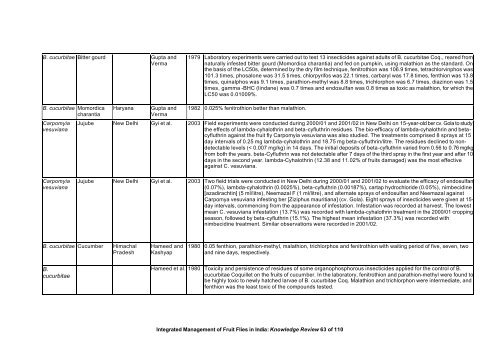“Key Informant Survey” of Production, Value, Losses and ... - DfID
“Key Informant Survey” of Production, Value, Losses and ... - DfID
“Key Informant Survey” of Production, Value, Losses and ... - DfID
Create successful ePaper yourself
Turn your PDF publications into a flip-book with our unique Google optimized e-Paper software.
B. cucurbitae Bitter gourd Gupta <strong>and</strong><br />
Verma<br />
B. cucurbitae Momordica<br />
charantia<br />
Carpomyia<br />
vesuviana<br />
Carpomyia<br />
vesuviana<br />
Haryana Gupta <strong>and</strong><br />
Verma<br />
1979 Laboratory experiments were carried out to test 13 insecticides against adults <strong>of</strong> B. cucurbitae Coq., reared from<br />
naturally infested bitter gourd (Momordica charantia) <strong>and</strong> fed on pumpkin, using malathion as the st<strong>and</strong>ard. On<br />
the basis <strong>of</strong> the LC50s, determined by the dry film technique, fenitrothion was 106.9 times, tetrachlorvinphos was<br />
101.3 times, phosalone was 31.5 times, chlorpyrifos was 22.1 times, carbaryl was 17.8 times, fenthion was 13.8<br />
times, quinalphos was 9.1 times, parathion-methyl was 8.8 times, trichlorphon was 6.7 times, diazinon was 1.5<br />
times, gamma -BHC (lindane) was 0.7 times <strong>and</strong> endosulfan was 0.8 times as toxic as malathion, for which the<br />
LC50 was 0.01009%.<br />
1982 0.025% fenitrothion better than malathion.<br />
Jujube New Delhi Gyi et al. 2003 Field experiments were conducted during 2000/01 <strong>and</strong> 2001/02 in New Delhi on 15-year-old ber cv. Gola to study<br />
the effects <strong>of</strong> lambda-cyhalothrin <strong>and</strong> beta-cyfluthrin residues. The bio-efficacy <strong>of</strong> lambda-cyhalothrin <strong>and</strong> betacyfluthrin<br />
against the fruit fly Carpomyia vesuviana was also studied. The treatments comprised 8 sprays at 15<br />
day intervals <strong>of</strong> 0.25 mg lambda-cyhalothrin <strong>and</strong> 18.75 mg beta-cyfluthrin/litre. The residues declined to nondetectable<br />
levels (< 0.007 mg/kg) in 14 days. The initial deposits <strong>of</strong> beta-cyfluthrin varied from 0.56 to 0.76 mg/kg<br />
from both the years. beta-Cyfluthrin was not detectable after 7 days <strong>of</strong> the third spray in the first year <strong>and</strong> after 10<br />
days in the second year. lambda-Cyhalothrin (12.38 <strong>and</strong> 11.02% <strong>of</strong> fruits damaged) was the most effective<br />
against C. vesuviana.<br />
Jujube New Delhi Gyi et al. 2003 Two field trials were conducted in New Delhi during 2000/01 <strong>and</strong> 2001/02 to evaluate the efficacy <strong>of</strong> endosulfan<br />
(0.07%), lambda-cyhalothrin (0.0025%), beta-cyfluthrin (0.00187%), cartap hydrochloride (0.05%), nimbecidine<br />
[azadirachtin] (5 ml/litre), Neemazal F (1 ml/litre), <strong>and</strong> alternate sprays <strong>of</strong> endosulfan <strong>and</strong> Neemazal against<br />
Carpomya vesuviana infesting ber [Ziziphus mauritiana] (cv. Gola). Eight sprays <strong>of</strong> insecticides were given at 15day<br />
intervals, commencing from the appearance <strong>of</strong> infestation. Infestation was recorded at harvest. The lowest<br />
mean C. vesuviana infestation (13.7%) was recorded with lambda-cyhalothrin treatment in the 2000/01 cropping<br />
season, followed by beta-cyfluthrin (15.1%). The highest mean infestation (37.3%) was recorded with<br />
nimbecidine treatment. Similar observations were recorded in 2001/02.<br />
B. cucurbitae Cucumber Himachal<br />
Pradesh<br />
B.<br />
cucurbitae<br />
Hameed <strong>and</strong><br />
Kashyap<br />
1980 0.05 fenthion, parathion-methyl, malathion, trichlorphos <strong>and</strong> fenitrothion with waiting period <strong>of</strong> five, seven, two<br />
<strong>and</strong> nine days, respectively.<br />
Hameed et al. 1980 Toxicity <strong>and</strong> persistence <strong>of</strong> residues <strong>of</strong> some organophosphorous insecticides applied for the control <strong>of</strong> B.<br />
cucurbitae Coquillet on the fruits <strong>of</strong> cucumber. In the laboratory, fenitrothion <strong>and</strong> parathion-methyl were found to<br />
be highly toxic to newly hatched larvae <strong>of</strong> B. cucurbitae Coq. Malathion <strong>and</strong> trichlorphon were intermediate, <strong>and</strong><br />
fenthion was the least toxic <strong>of</strong> the compounds tested.<br />
Integrated Management <strong>of</strong> Fruit Flies in India: Knowledge Review 63 <strong>of</strong> 110

















